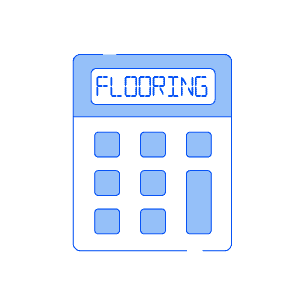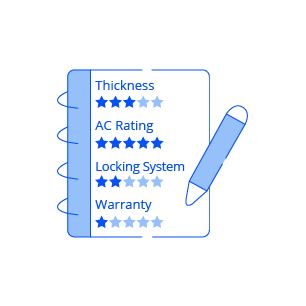Learn everything insiders know about how to buy laminate flooring.
Carpet Captain doesn’t sell flooring, but we have helped nearly one million people buy it
without a sales pitch.
Captain’s Laminate Highlights


- Newer laminate technology can make it look surprisingly like hardwood
- AC rating is the most important indicator of laminate durability: 3 is perfect for many homes that need durability
- An underlayment is worth the investment in 95% of laminate projects
- It’s one of the easier DIY jobs, but if you go with an installer, who you choose is still important
Chapter 1. Laminate pros and cons vs other floor options
Are you already 100% sure you’re going with laminate for your flooring project?
Then, you can skip this and move on to chapter 2. But flooring is a huge investment, so I recommend most people at least skim these pros and cos.
Pros of laminate flooring:
- new laminates can look surprisingly similar to hardwood
- low maintenance: the hard smooth surface is easy to clean and no need for refinishing
- value flooring: it’s about as cheap as you’ll find any flooring project
- easy DIY with snap together laminate planks
- resistant to stains
- no messy and indoor-air-polluting glues needed
- floating laminate can be installed over old flooring
Cons of laminate flooring:
- looks similar to hardwood, but the feeling underfoot isn’t the same. doesn’t have the luxury “vibe”
- cannot be refinished: this means when it’s scuffed up it’s likely time to replace
- sitting moisture causes it to bubble and destruct: newer engineering is improving this but I’d still avoid it bathrooms and basements
- doesn’t improve home values like hardwood
- needs a smooth floor underneath and likely needs underlayment (slight added cost/work)
So, what is laminate flooring’s competition?
So after reviewing the pros and cons, is there another flooring should you consider?
I have guides on the 7 most popular types of flooring (and have articles on more), and each type of floor is perfect for a certain situation. You can read about all my favorite flooring options.
But I find there are two major competitors to laminate:
The first is hardwood. It’s what laminate is trying to be. If you have extra money to spend, hardwood is more durable, looks and feels better, and has a better resale value. I almost always think it’s worth it. You can read about laminate vs hardwood.
Most people looking at laminate don’t want to throw down the money for hardwood. But there’s another flooring that is even a closer cousin to laminate. That floor is luxury vinyl planks (LVP). It looks similar to laminate, costs similar, but it’s more water-resistant. Read about LVP vs laminate.
Chapter 2: Are you financially prepared? Cost, budgeting, and paying
This is another question you have to ask yourself, but it probably won’t eliminate laminate. Laminate can be one of the less expensive flooring options. With that said, flooring can be a shocking big investment. It’s worth budgeting to make sure you know what you’re getting yourself into.
What does laminate cost?
Laminate is one of the more affordable types of flooring. But have you checked out the cost of flooring? Unless you’re flooring a small room, you’re likely investing in the thousands. Big flooring projects can be upward of 10k.
You can save big on laminate vs hardwood, but this is what you can expect to pay:
Average laminate cost per square foot (materials only): $3
Average laminate cost per square foot (installed): $5
Multiple the $3 times the number of square feet you need if you’re installing yourself, or multiply $5 times the square feet if you will be hiring someone to install the laminate.
This brings us to our next question.
How much laminate flooring do I need?
Your installer will figure this out for you, but since laminate is often a DIY floor, it helps to know how to figure it out yourself.
Good news:
It’s simple to do. Just take out a tape measure and measure the length and width of your room. Multiply the two together. That gives you the square footage.
Two more things to take into account: laminate comes in boxes (usually 20 sqft per box), and you need to have extra for waste.
To calculate the square footage needed with waste, just multiply the square footage by:
1.05 for 5% waste
1.10 for 10% waste
1.15 for 15% waste
1.20 for 20% waste
This is your required square footage. Then, take that number and divided it by 20 (or however many square feet of laminate come in each box). This is the number of boxes you need.
 Captain cut some corners! This is the simplest and way most people use to estimate the amount of laminate needed. You might have realized that often this will come with a fraction of a box, eg. Need 7.3 boxes. The easy way to fix this is to round up (rounding down can leave you short), but this can also waste money. For more detail that can help you save money and more accurately measure laminate (including things like stairs), check our costs and measuring laminate page.
Captain cut some corners! This is the simplest and way most people use to estimate the amount of laminate needed. You might have realized that often this will come with a fraction of a box, eg. Need 7.3 boxes. The easy way to fix this is to round up (rounding down can leave you short), but this can also waste money. For more detail that can help you save money and more accurately measure laminate (including things like stairs), check our costs and measuring laminate page.Making a budget.
For an estimate, I can make this simple for you: Total cost of project = Number of boxes needed * 100.
Where did 100 come from? The standard is 20 sqft. per box, and the average cost of laminate installed is $5 sqft: 20 * 5 = 100.
Of course, this calculation gives you a ballpark. If you want to come up with a more accurate measurement, check out our laminate costs page. Why would you want a more accurate measurement? A couple of reasons:
The first is so you can have an accurate idea of what you’ll pay. Ballpark estimates can leave you surprised at the cash register.
More importantly, so you can “audit” the store and installer. One of the easiest ways to get ripped off by a couple hundred dollars is by over-inflated measurements. 99% of shoppers won’t notice the difference on their invoice. If you budget accurately, you’ll be the 1%.
Chapter 3. Durability factors. What matters, and what doesn’t
You’ll see all kinds of specs listed with each laminate.
In the sea of information, what matters?
Let’s go over common information you’ll find, and whether it is important or not to how long your laminate will last.
Laminate thickness
One decision you’ll always run into when buying laminate is:
What thickness do you want?
Laminate comes in thicknesses of 6mm to 12mm. The thicker the laminate the easier it is to install, the less sound echoing there will be, and the more quality the laminate will look and feel.
So what is thick enough?
I recommend most people go with 10mm or 12mm. This will give you laminate a quality feel and give some insurance against a not perfectly level subfloor.
This is an important enough category that I recommend checking out our page dedicated to laminate thickness.
AC rating
AC rating is one of my favorite durability ratings for any floor. It doesn’t mislead you as often as some other flooring durability indicators.
It’s a simple 1-6 scale. The higher the number, the more durable the floor.
Laminates rated AC4-6 are considered commercial floors.
Laminates rated 1-3 are for homeowners. Most rooms that get daily traffic, you’ll want to go with an AC3 rating. This may be the most important decision you make with laminate, so check out our page on laminate AC ratings for more detail.
Warranties
Many shoppers default to warranties to choose how durable their floor is. It’s simple, and it seems to make sense. Why would a manufacturer put a long warranty on a crappy product?
Truth is:
Warranties tend to be longer for higher-quality floors, but I still don’t like using it to make your flooring purchase decisions for a few reasons:
- the fine print in some warranties makes them useless
- there’s no standard: a better laminate from a different manufacturer may have a shorter warranty
- your specific situation may ruin the laminate but not be covered by a warranty
If you insist on going by warranty, just know that a “15-year warranty” doesn’t mean that it will be replaced any time its damaged in 15 years. It means it will be replaced if the damage fits the exact type of damage that is in the legal document you probably didn’t read.
Installation types
Laminate will be installed in different ways depending on what you buy. This won’t have a huge impact on durability, but it will impact how easy it is to DIY.
And in some ways, that does affect the durability because, if you want to replace a damaged laminate piece, it’ll be easier or more difficult depending on the type.
Tongue and groove. Also known as “click lock,” tongue and grooves is the easiest and most common laminate locking system. You just snap the tiles together. If you want to DIY, this is the way to go, but even if you’re hiring an installer, this type will save on cost.
Glued laminate. Exactly how it sounds, glued laminate uses glue to stick the plans together. Glued laminate can come in pre-glued plans where you just add moisture to the edge to activate the glue. This takes more time and effort with the trade-off being a tight seal once it’s installed.
Mechanical system. There is also a “mechanical” locking system that uses an aluminum guide beneath the laminate. You’re less likely to run into this type of floor.
So which of these should you choose?
Most homeowners will like tongue and groove, especially if you want to DIY. But there are a couple of things to consider:
- Glued laminate is like to have buckling or other issues post-installation
- Glued laminate is easier to replace one tile. This may seem the opposite of what you’d think, but it’s a lot easier to rip up one glued tile than it is to unsnap a “tongue and groove” laminate piece that is in the middle of the floor (you’d have to take up an entire section)
Aesthetic/interior design
I just covered the boring aspect design, but the aesthetic design is the fun part–at least for some. Me personally, I don’t take too much pride in my interior design choices, but I do know some of the design options you’ll have:
- color tones: wide range even within specific colors (ie about 100 different grays)
- texture and finish: the surface can range from glossy to a swirled rustic wood appearance
- other design details: plank width, edge style, and layout direction can all make more of a difference than you think
 Captain’s warning! Don’t be disappointed in your color choice after its already installed. A common mistake is to select a color in-store. Laminate changes color in your home because the lighting is different–it can be a dramatic difference! Make sure to take a sample home, or at least lay out the new laminate, before going to the trouble of installing it.
Captain’s warning! Don’t be disappointed in your color choice after its already installed. A common mistake is to select a color in-store. Laminate changes color in your home because the lighting is different–it can be a dramatic difference! Make sure to take a sample home, or at least lay out the new laminate, before going to the trouble of installing it.Check out Carpet Captain on Pinterest for design ideas from straightforward to wild. You will be surprised at the designs people come up with (one mixed carpet tiles and laminate to make a heart design).
Chapter 4: Underlayment
So you didn’t get underlayment attached, but is it required? If you don’t, you’re asking for headaches down the road. But, there are cases where you may be able to pull of direct-to-floor laminate. There are two keys: the subfloor has zero moisture problems and is perfectly level. This is a rare combination, but you might find it when installing on top of vinyl tile or on a brand new subfloor.
Underlayment attached or separate
Some laminate floors come with the underlayment attached. They may advertise that it makes the laminate more comfortable, a better sound barrier, and make installation easier. All are true, but you can easily buy underlayment separately.
Buying it separate allows you to choose your underlayment. You’ll likely get an equivalent for better underlayment for less cost buying it separately.
 Captain’s warning! If you buy laminate with underlayment attached, you may be tempted to add your own to make sure you get all the benefits: improving installation, sound-barrier, and soft underfoot. This will backfire. Never double up the underlayment. It will reduce the support under the laminate and cause the installation to tear apart.
Captain’s warning! If you buy laminate with underlayment attached, you may be tempted to add your own to make sure you get all the benefits: improving installation, sound-barrier, and soft underfoot. This will backfire. Never double up the underlayment. It will reduce the support under the laminate and cause the installation to tear apart.Now let’s talk about the 99% of cases where you need underlayment. What are your options?
Most likely you’ll want to go with a standard foam underlayment. Foam comes in different quality levels. The more economical foam underlayment will do a good job in most cases, but you can upgrade to get better sound dampening and also moisture resistance. Remember, a moisture barrier is required if you have any moisture issues (not sure? you can buy kits to test it).
What will underlayment cost? Expect to pay $0.25 sq/ft. for stand underlayment. Buying premium? The price for premium underlayment can go up to $1.50 sq/ft.
You can see that going with cheaper laminate saves you hundreds of dollars even on small jobs. If you’re considering upgrading, check out our complete guide on underlayment for laminate.
Chapter 5: How to buy laminate and get the best deal
We’re in the final stretch. You know what type of laminate you want, the specs, and about how much it will cost.
Now let’s good a good deal on it. There are a 3 things to consider when looking for a deal: where you buy, when you buy, and if you can talk them don’t on cost (without it being awkward).
Where should I buy laminate?
You’ll buy your laminate at a local or regional store, big-box store, laminate-to-your-home seller, or online. There’s no right or wrong answer for everyone on where you should buy, but there is a right or wrong place for you.
Check out my article on where should you buy your flooring. It’ll give you a breakdown of the pros and cons of each type of floor.
When should I buy it?
Basic economics of supply and demand applies to flooring. The fewer people in the store looking for flooring, the more likely the store is to cut you a deal. So when is demand low?
The best time is during the holidays: mid-December to early January. Most people are too busy to even think about flooring. Don’t want to wait until winter? You might also find a discount in late May. School is wrapping up, and it’s a couple of months before the major remodeling season.
But there are other things to consider. The first being personal reasons—when do you need your floor? Also, flooring installation can emit fumes. Laminate isn’t as bad as some floors, but still, I’d consider installing during a time when you can get some ventilation in your home.
For more details, check on what time of year should I buy flooring?
Negotiating and other ways to get the best deal
Most stores have some room for negotiation. Even big-box stores sometimes have wiggle room.
It helps to read up on negotiation.
A little win on a flooring project is a big win for you because it’s such a big investment. I cover how to negotiate flooring without an awkward stand-off in detail. Most flooring stores are happy to give you a good deal–it means a happy customer and a sale for them.
Chapter 6: Hiring installers, DIY, and preparing for installation day
Now we’re on the final stretch. Time for laminate installation.
Your first decision is…
Should I hire an installer or DIY?
Laminate is one of the easiest DIY floors. But that doesn’t mean you should. Here are reasons you might want to hire an installer:
- Health issues keeping you from moderate physical activity and being on your hands and knees
- Installers will guarantee good work. You have to be willing to make mistakes
- Do you enjoy home improvement projects? If not, your time is probably worth what you’ll pay an installer.
On the other hand, these are the reasons you might want to DIY:
- You’re frugal. Time is not an issue you just want to save some money.
- You enjoy home improvement projects
- You’re willing to make some mistakes. Some money you save on installation may be lost due to installation errors (needing more flooring, materials, etc).
Decide to DIY? Here’s a thorough and easy to follow article on how to install laminate flooring.
How to hire a competent installer
If you hire an installer, you hire him to get the job done right and avoid headaches. The bad news is you can just hire any installer. Unfortunately, there are some installers who are either incompetent (don’t know what they’re doing) or shady (intentionally rip you off). The good news is there are many great installers and laminate isn’t particularly difficult. Here are some steps you can take to boost your odds of a good installer:
- Ask friends for recommendations
- Check 3rd party ratings: Angie’s List, Better Business Bureau, Google, and other reputable online sites
- Quiz the installer with conversational questions (see below)
- My favorite: Use our installer matching service that does the homework for you. How does it work? You just enter your zip code and a little information on your project, and you’ll get bids from 3-4 pre-qualified installers in your area. Click here to try it out.
What questions can you ask?
- Are you bonded and insured? In other words, do you have a financial backup if the installer messes up something big or the installation leads to injury? Not a must-have, but it definitely makes me more comfortable–especially if you’re not 100% sure about the installer.
- What happens if the installation goes poorly? Many times this can be manufacturer related, but what if the manufacturer says it’s the installer? What will the installer do? Get this in writing.
- You can also bring anything up you’ve learned here as a question. E.g. What is important when installing laminate? Answers can vary, but you’d expect a response including level flooring, moisture, and underlayment.
Installation day checklist
The installer is on the calendar. What do you need to do to prepare? Your laminate should sit out 48 hours before being installed to acclimate to your environment. This will prevent a change in the laminate structure after its installed.
First, make sure the laminate arrives at least 48 hours prior. You want to sit it out in your home, so it acclimates to the environment. This ensures it’s stable before its installed, improving installation success.
Make sure the laminate is what you expected. Go over your exact receipt to ensure it matches. How does the color look in your home? It may be different than it looked in the store. You can still take the laminate back at this point.
Open windows if possible. Laminate isn’t the biggest criminal when it comes to releasing indoor air pollution, but anytime I bring new construction material into the home, I like to get fresh air moving through. And ideally, I leave the house. This goes for pets, too.
Hired an installer? Give him room to work, but also don’t be over-trusting. Clean up the area, so there are no “temptations” for theft. And more importantly, so you don’t blame him for the watch he stole (that you later find in your jewelry box). Speak of jewelry, lock up or remove anything that is highly valuable and easy to steal.
Captain’s parting words!
Laminate isn’t difficult, but the details are important. And since you’ll invest a chunk of money on any flooring, it’s worth getting the details right the first time.
The 10 minutes you spent reading this guide won’t make you an expert. It will make you a smart shopper. So much so, you’ll like catch salesman off-guard. And that equals better deals.
Now it’s time to enjoy your floor. One other cool thing about laminate: it’s low maintenance. Outside of occasional vacuuming/sweeping and mopping, it’s hands-off.
I’ve also gathered the best mops for laminate floors in case you’re looking for one.
No yearly refinishing or deep cleaning that hardwood and carpet require.
Anything that I didn’t cover on how to buy laminate flooring? Let me know in the comments below.








Thanks for the blog, very helpful! I am looking at purchasing a 10mm laminate floor from lumber liquidators. My only concern is the install type, it seems to be a “Drop and lock” type with no tapping & clicking together, it just lays in the groove. My concern is if this will give a nice tight seem and will it stay together?
Glad it’s helped! I don’t have personal experience with their installation, but I haven’t heard anyone complain of it being loose. It likely snaps together with the grooves and between that and the floor going wall-to-wall it will hold together well.
Thank you for the information. Can you please explain to me how some salespeople can scratch the heck out of laminate and it doesn’t show, but lots of users say their laminate scratches like crazy in just months of time? Who is doing what, and who is right? Thanks.
Some of it might be people buying cheap laminate, and the salespeople (possibly) actually selling a better wear layer. Wear layers have definitely improved over time. Also, I the general wear on the laminate hits it over time, not just one incident.
Thank you very much for all the information, question I bought 12mm laminate maple rustic not knowing anything about AC ratings or better yet not having any knowledge on laminate products, so my worry is I have no idea what the AC Rating is because none of the boxes indicate it nor the installing instructions, I ordered the merchandise on line but and I’ve called and talked to the customer service but no one seems to know what I’m talking about, sad I feel about the situation.
Well, I guess in that case you just hope it works out or return it 🙁 The thickness won’t tell you much.
Your article was the most useful. Am planning to redo floors in laminate. Have spent time going through online recommendations and I learnt more in ten minutes reading your article that weeks of online research
My goals to give shoppers what they need without a sales pitch and nothing more, so I’m glad to hear this!
Did your process work? Looks it is much easier than hard selling people every time which is very stress full. https://www.housecleanersk.ca/
My home has radiant heated floors, Will I have an issue with Laminate?
No, laminate definitely works. Make sure your underlayment is approved for laminate. You’ll also want a good installer (there are a few nuisances like running the radiant heat prior to make sure subfloors are dry, acclimation, etc). Make sure to read the manual of the radiant heat and your laminate specifically–there could be some exclusions.
Thank you for this helpful information. Can I get your opinion? My husband and I have spent hours shopping for a wood-looking laminate for our home. We’ve found a product we like, but I’m nervous because the price is so low (69¢ /sq ft)
The AC rating is 3 and it’s 8mm thick. We want to install it in our living room, office, entryway, hallway and dining room (so not much risk for water damage I hope). https://www.flooranddecor.com/laminate-flooring/essential-oak-2-strip-matte-laminate-100490283.html
Do you think if I pair this with a high quality underlayment that it will help the floor feel and sound a little nicer than it is? The underlay I’m looking at is STC rating 63 and IIC rating 74.
I just don’t want to make a mistake and buy garbage. But our testing shows this floor seems very durable (we can’t scratch it with a screwdriver) which on other more expensive laminates we’ve been able to make big scratches. We have 3 small children and they somehow find a way to ruin everything. But this product *seems* durable, but maybe a little on the thin side. Do you have experience or advice for us?
Thank you!
I’m not familiar with this specific laminate, but it sounds like you’ve done a good job researching. My guess is it may look and feel a little cheaper than more expensive laminates (possible design/textures, and also the 8mm thickness isn’t bad but may feel a little flimsy underfoot), but it will hold up well with your family. Sounds like you don’t have moisture problems, but I’d also guess it’s not great against moisture resistance. Assuming it passes the looks and feel test for you, I think it could be a good option and a great value (at that price you could replace it a lot sooner than expensive laminate as well!).
Thank you!
One point: Big box store offerings, even for decent manufacturers, is a lower quality product. I recently put in Mohawk’s RevWood, which has male/female locking ends on all 4 sides. I could not believe the difference in the thickness of not only the flooring itself when compared to Big Box Mohawk floors, but also the thickness of the locking strips. None were dented, stripped off or missing corners or pieces in all the boxes we opened in the RevWood. We installed 560 sq ft. If you open some of the flooring boxes of the junk from a big box, you will see the snap mechanism edges broken off and cracked, and those cheaper floorings don’t actually “snap” when they go together. Day and night difference. We found our flooring at an “outlet” type of store, which is an off-shoot of a major tile/flooring store in our area. We paid $3.99 a sq ft just for the flooring, plus bought the upgraded underlayment, and $1,100 to install it by a flooring professional and also install baseboards. It cost us a bit more, but we know it’s going to last even with two little rescue doggies running amuck (they actually seem to enjoy the slippery aspect of the floor. One of my dogs has figured out how to slide on it and you can see her smiling when she does it. It’s hilarious–no damage to the floor). We have slid plastic footed furniture all over the floor and appliances, with zero scratches. Because this flooring is 4 sided locking, it’s considered water-proof even if a puddle sits on it for several hours. It looks beautiful, and we are very happy with our decision to pay a bit more for a quality product. A big box floor may work for some, but know, it’s not going to last, and won’t perform if you need it to be really durable to a host of abuse. We ripped out a big box floor that had the laminate worn off it in high traffic areas (around the front door, and under where the dining table chairs slid in and out). Granted, we bought this house recently, so we did not put the damage on it, but we knew the seller well prior to the sale, and we knew where they got the flooring. Just an FYI for people who are not on the inside. I learned a bunch in this process. Hope it helps someone.
DK
Good to hear your experience, but I haven’t heard the same (from industry or flooring shoppers). I don’t think big box stores would get lower quality product with the same brand names as other stores.
Thank you very much for your detailed information. It encouraged me a lot and I decided to DIY.
I plan to replace all indoor carpets with laminate. My house has two floors and I plan to start with the upstairs. I have some questions. Would you please give me your answer.
1. Is it a good idea to install laminate on the upstairs first? Should I start installing laminate on downstairs first to gain more experience before working upstairs?
2. Since the subfloor of upstairs is plywood, does it need underlayment attached? Do you have any special recommendations to install laminate on plywood on the upper floor.
3. I have watched a lot of videos showing me how to install laminate on the stairs. They instructed me to glue laminates on the surface of stairs. What is a better “locking type” should I use for installing laminate on upstairs on plywood: “glued laminate” or “tongue and groove”?
Thank you very much,
1. I’d start with the rooms you won’t care if they don’t look as great first 🙂 –so probably upstairs 2. You can read about reasons for laminate underlayment here, but basically, I recommend it in almost all cases 3. tongue and groove is easier in my opinion for your main flooring areas
Thank you. Very helpful indeed.
Thanks for letting me know it helped!
Have you completed your laminate brands review? It would be a real help to me.
I have a review of one of the most popular laminate brands, and it also covers the challenges in reviewing brands. I haven’t done a general brand review of laminate because the brand landscape is always changing, and there is often a big variance in quality within brands.
What do you think of the Pergo Outlast+, how does it compare to other laminates?
It’s above average but not invincible. Pergo (in general) gets mixed reviews, but this is one of their highest end floors. Consumer Reports rated it tops in laminate. That said, I think expectations are important to be happy with it. Pergo often advertises to be “worry-free” and high-end durability. While they are good, it’s still laminate and not different than other high-quality laminates: scratches and water damage can still happen even if its improved on early versions and cheaper laminate.
Hello! Love your advice, Captain.. I am looking to replace flooring in a currently carpeted living room and dining room, and also an entrance hallway which is currently hardwood. I picked out a Manning Restoration laminate that I really like for color and pattern. The salesman at the flooring store keeps pushing LVP because it is waterproof, but I have not found one that I like the look of., and I have seen several negative reviews because it scratches easily. I have a large dog. This area is not a high moisture area., and I plan on area rugs at the hallway entrance. Should I just go with what I like? And what are your thoughts on this laminate brand?
Thanks! He’s right that the big separation between luxury vinyl and laminate is moisture resistance. But does your dog pee often? Or any other moisture problems? If not, I’d say go with the laminate since you like the look better (after all, look and feel is really what matters in flooring, and it’s ability to keep it’s new look and feel over time). I need to do laminate brand reviews sometime soon. If you find a luxury vinyl you look, make sure to check out my LVP guide; it will help you find vinyl that resists scratches (scratches shouldn’t be a problem with the right product). As for Mannington, they’re a bigger brand and I think with that you get mixed opinions. I’ve seen some say they had problems and the customer service was poor, but I’d imagine they have good products as well. I don’t have much experience with them, but I need to do a brand review on laminate soon.
Thank you< Captain. My dog that peed a lot has passed over the Rainbow bridge at 16 years old. We are sad for sure, but it's been a long wait for new flooring! Looking forward to your laminate reviews. Hopefully it will be before e buy!
When do you plan on buying? I might be able to get something at least partially complete by this weekend.
I would LOVE a laminate brand review. We are going to start a remodel in Jan. 2019 and I would love to use laminate or hardwood.
Seems to be a popular request, so I’ll have to see if I can make the time to dive into it.
Hi I am wondering which would be better if one has cats. LVP or laminate? My cats like to run wild across the floor, I’m afraid of scratching and gouging with LVP. I also need water resistant due to old dog and would like to have same flooring in bathroom. I’ve seen some laminate that says it guaranteed water resistant and safe for use in bathrooms.
Standard laminate is terrible when it comes to moisture, but newer technology has been a game changer. I’m not ready to have it in my bathroom yet, but some say you can, and I’d be comfortable with it with pet urine or in a kitchen. That said, you have to get the best laminate products. Luxury vinyl is naturally moisture resistant. And if you get a good wear layer (you can read more in our vinyl plank guide), you won’t need to worry about scratches. At the end of the day, I think you can do either, you’ll just have to be more selective with laminate.
I appreciate this blog so much, this really is going too be a major investment for us. I was wondering what your thoughts are on the laminated floor made in China?
Many floors are manufactured outside the United States. The biggest issue can be fewer regulations. This is particularly true with luxury vinyl flooring where there are potentially harmful off-gassing chemicals in the floor. For laminate, this isn’t as much the case. However, there are differences in brand qualities. If you read this guide, pick out the specifications of the floor you want, and you like the look and feel of it I don’t think it will matter as much where it is made (unless, of course, you want to support U.S. manufacturing).
Hello,
Is there a way to achieve a seamless room transition application using laminate or LVP?
Yes and no. Most of the time you go from room to room the manufacture requires moldings between doorways because expansion/contraction of the planks can cause a gap without it. However, there are times where people pull off no molding. You’ll want the laminate going the same way in both rooms. This should be parallel to the longest wall, but if that’s not the same in both rooms, you’ll just have to choose which direction looks best to you.
Great info thank you!
I started out wanting hard wood or some wood looking product on the entire first floor, someone told me I had to do LVP if going in a kitchen so I limited my choices to that. I then got told I could in fact do hardwood and that many new construction etc use hardwood in all rooms. I pursued that and just think it is too expensive so was going to go back to LVP but it occurred to me that if I am not concerned with being waterproof then is a laminate a better option? Someone told me that laminate was more scratch resistant than the LVP so if I care more about scratching than I do water would you recommend laminate?
I don’t necessarily prefer laminate for scratches; luxury vinyl can be very good with a thick wear layer (more on that in the luxury vinyl guide). And I think most kitchens are prone to some moisture, so luxury vinyl may be preferred for that reason. That said, newer laminates can have decent moisture resistance, so if moisture isn’t a big problem (unlike a bathroom, it’s not always a problem in the kitchen), I think it’d be fine to go with laminate if that’s what you prefer. One of advantage of laminate is vinyl is a plastic… luxury vinyl has come a long way to take toxins out of it, but this historically is a less of an issue for laminate.
does anybody still sell:
1) Hartco Pattern Plus, 2-Ply Oak, 27″, Permion finish hardwood laminate?
2) Mohawk Karastan Ultra Sponge Rubber Cushion Padding (C102603101) by the roll?
I’d try calling Hartco/Mohawk directly. I’m not sure on these specific models. They should be able to tell you and maybe even what stores you can find them at. If they’re no longer produced, and you really want to hunt for it, you could try calling local and big box stores in your area. Sometimes they’ll have old stock of discontinued flooring.
Thank you so much for info, very helpful!
Glad it helped… enjoy the new floors!
Hi I was just wondering if you recommend laminate when people have dogs? Is it durable under those conditions?
I like it for pets. There’s really no perfect floor, but these are the main drawbacks: it’s not very moisture resistant if your dog pees on it, and it can be slippery which your dog might not like. Otherwise, it’s fairly durable and relatively cheap and easy to replace individual pieces if it does get damaged. I think it’s a good choice, but it might not be your dogs favorite (going with a laminate with a slightly textured surface can sometimes help your dog’s traction if she’s older or you think it would be an issue).
Thank you so much for the on point and practical information. Your article really helped me key in on what to look for and how to plan for my flooring needs. This was extremely useful information.
Appreciate it, Vicky!. I plan on bringing research to other types of flooring as well, so feel free to check back with any future flooring decisions.
These are great articles! Is it particularly difficult or costly to replace carpet with laminate?
Thanks Ginny! Short answer is no it’s not difficult or expensive. Longer answer is it depends. Typically you can just rip your carpet up–this is a fairly easy DIY job, but you could hire someone. The most difficult part is making sure your floor beneath is level enough for the new laminate. I’d recommend getting the advice of someone with experience here. Assuming the floor is in decent shape and you DIY your carpet removal, it’s no more expensive than the laminate itself (which can be pretty cheap for flooring).